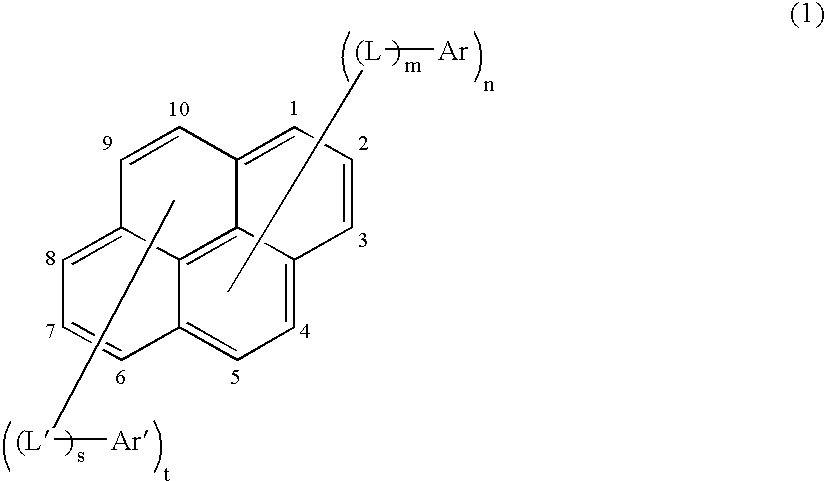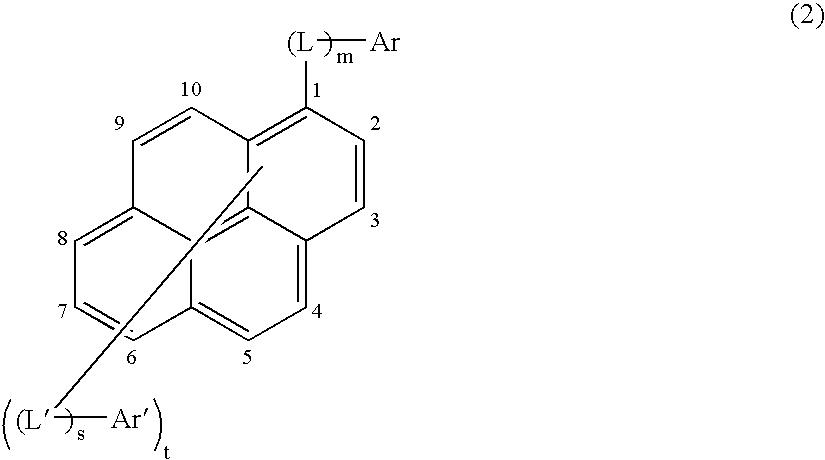Asymmetric pyrene derivative and organic electroluminescence device employing the same
a technology of organic electroluminescence and pyrene derivative, which is applied in the direction of discharge tube/lamp details, group 4/14 element organic compounds, natural mineral layered products, etc., and can solve the problem of not being easily affected by oxidization
- Summary
- Abstract
- Description
- Claims
- Application Information
AI Technical Summary
Benefits of technology
Problems solved by technology
Method used
Image
Examples
synthesis example 1
Synthesis of Compound (AN-2)
(1) Synthesis of Intermediate [1-bromo-6-(4-naphthalene-1-yl-phenyl)pyrene]
[0128] 7.4 g of 4-(naphthalene-1-yl)phenyl boronic acid prepared by a well known method and 7.0 g of conventional 1-bromopyrene were dissolved in 80 ml of dimethoxyethane (DME). Subsequently, 0.58 g of tetrakistriphenylphosphine palladium and 40 ml of 2M-sodium carbonate aqueous solution were added therein, followed by argon displacement. After heating and refluxing over 8 hours, it was stood to cool and then an organic layer was extracted therefrom by toluene. The organic layer was washed by saturated salt water, followed by drying through anhydrous sodium sulfate, and then the organic solvent was removed by an evaporator. The residue was refined through a silica gel chromatography (a developing solvent: toluene) and then 10.0 g of 1-(4-naphthalene-1-yl-phenyl) pyrene was obtained. (yield: 99%)
[0129] 10.0 g of 1-(4-naphthalene-1-yl-phenyl)pyrene obtained was dispersed into 100 m...
synthesis example 2
Synthesis of Compound (AN-7)
[0132] 2.3 g of 3-(naphthalene-2-yl)phenyl boronic acid prepared by a well known method and 3.8 g of 1-bromo-8-(4-naphthalene-1-yl-phenyl) pyrene were dissolved in 40 ml of DME. Subsequently, 0.19 g of tetrakis(triphenylphosphine)palladium and 13 ml of 2M-sodium carbonate aqueous solution were added therein, followed by argon displacement. After heating and refluxing for 9 hours, it was stood to cool and then an organic layer was extracted therefrom by toluene. The organic layer was washed by saturated salt water, followed by drying through anhydrous sodium sulfate, and then the organic solvent was removed by an evaporator. The residue was refined through a silica gel chromatography (a developing solvent: hexane / toluene=1 / 1) and then 2.7 g of the objective compound (AN-7) was obtained.
[0133] The measurement result of the compound by FD-MS showed m / z=606 to C48H30=606, therefore the objective compound (AN-7) was confirmed (the yield: 58%).
synthesis example 3
Synthesis of Compound (AN-3)
(1) Synthesis of Intermediate [1-bromo-6-(naphthalene-1-yl)pyrene]
[0134] 1-naphthalene boronic acid in place of 4-(naphthalene-1-yl)phenyl boronic acid was used in Synthesis Example 1 (1), and then 1-bromo-6-(naphthalene-1-yl) pyrene and 1-bromo-8-(naphthalene-1-yl) pyrene were obtained.
(2) Synthesis of Compound (AN-3)
[0135] The procedure of Synthesis Example 1 (2) was repeated except that 4.0 g of 1-bromo-6-(naphthalene-1-yl)pyrene and 1.85 g of 2-naphthalene boronic acid in place of 4-(naphthalene-2-yl)phenyl boronic acid and 1-bromo-6-(4-naphthalene-1-yl-phenyl)pyrene were used, and then 2.7 g of the light-yellow crystalline objective compound (AN-3) was obtained.
[0136] The measurement result of the compound by FD-MS showed m / z=454 to C36H22=454, therefore the objective compound (AN-3) was confirmed.
PUM
| Property | Measurement | Unit |
|---|---|---|
| Length | aaaaa | aaaaa |
| Time | aaaaa | aaaaa |
| Time | aaaaa | aaaaa |
Abstract
Description
Claims
Application Information
 Login to View More
Login to View More - R&D
- Intellectual Property
- Life Sciences
- Materials
- Tech Scout
- Unparalleled Data Quality
- Higher Quality Content
- 60% Fewer Hallucinations
Browse by: Latest US Patents, China's latest patents, Technical Efficacy Thesaurus, Application Domain, Technology Topic, Popular Technical Reports.
© 2025 PatSnap. All rights reserved.Legal|Privacy policy|Modern Slavery Act Transparency Statement|Sitemap|About US| Contact US: help@patsnap.com



